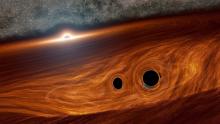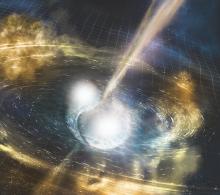Listen to today's episode of StarDate on the web the same day it airs in high-quality streaming audio without any extra ads or announcements. Choose a $8 one-month pass, or listen every day for a year for just $30.
You are here
Pulsing Waves
A low “hum” ripples through the universe — the possible rumble of pairs of supermassive black holes. The waves that make up the hum are light-years long, so they’re hard to pick up. In fact, you need a receiver as big as a galaxy. And astronomers recently discovered the hum using such giant receivers.
Gravitational waves are ripples in space-time created by the motions of massive objects. Scientists have detected the waves produced by the mergers of smaller black holes. But the waves produced by supermassive black holes are much too long for detectors here on Earth.
Instead, astronomers have created galaxy-spanning detectors using pulsars — the ultra-dense corpses of exploded stars. They spin at up to hundreds of times per second, sending out “pulses” of energy. The spin rate is extremely stable, so a pulsar “ticks” like a very steady clock.
But when a gravitational wave passes between Earth and a pulsar, the pulsar spins a bit faster or slower. Since the waves are so long, it can take years to see a difference in the timing. Combining observations of many pulsars over many years makes the changes easier to see.
Several teams of astronomers have measured those changes. They say the most likely explanation is waves from pairs of supermassive black holes that are about to merge. Their work shows that millions of such mergers could be in progress — producing a deep “hum” across the universe.
Script by Damond Benningfield





